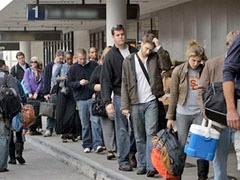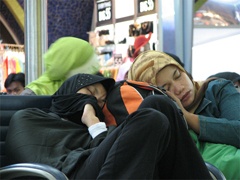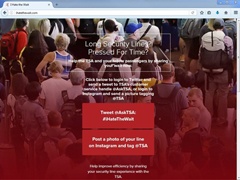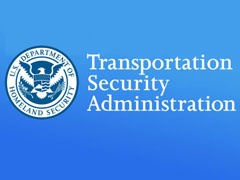 Security screener shortages and increased passenger volume at the airport - doesn’t make for a good combination, does it. Unfortunately, that’s exactly what the US Transportation Security Administration (TSA) is facing at the moment.
Security screener shortages and increased passenger volume at the airport - doesn’t make for a good combination, does it. Unfortunately, that’s exactly what the US Transportation Security Administration (TSA) is facing at the moment.
The recovering economy and low price of airfare has boosted the volume of passengers flowing through airports. This uptick is wreaking havoc on the busiest US airports including Atlanta, Chicago, Dallas, and New York since passengers are unable to get through security fast enough. The strain is being felt on everyone including passengers, airports, and airlines.
Passenger Frustration is Strong
 Passengers are frustrated and the pleasant passenger experience the aviation industry aims to achieve is rapidly deteriorating. Many have missed their flights because of extensive airport security queues. Waits have been reported to peak at one hour and 45 minutes to two hours just to get through security alone. As a result, some passengers have been forced to spend a night at the airport while waiting for the next available flight out in the morning.
Passengers are frustrated and the pleasant passenger experience the aviation industry aims to achieve is rapidly deteriorating. Many have missed their flights because of extensive airport security queues. Waits have been reported to peak at one hour and 45 minutes to two hours just to get through security alone. As a result, some passengers have been forced to spend a night at the airport while waiting for the next available flight out in the morning.
Incoming passengers have now been advised to arrive at least three hours ahead of departure time in order to get through security. For some, this queue time is longer than their actual flight.
The Strain on Airports and Airlines
 Airports have expressed their discontent with letters to the TSA demanding more security screeners for their checkpoints. If they don’t get the support they require, airports will be forced to hire private screeners to handle the security checkpoint. Some have already begun to research how other airports have implemented security screening without the TSA.
Airports have expressed their discontent with letters to the TSA demanding more security screeners for their checkpoints. If they don’t get the support they require, airports will be forced to hire private screeners to handle the security checkpoint. Some have already begun to research how other airports have implemented security screening without the TSA.
Airline industry group, Airlines for America (A4A), has encouraged flyers to post a photo of long checkpoint lines to social media with the hashtag #IHateTheWait. The campaign aims to emphasize the need for more TSA resources at the checkpoint. It also serves to inform other travelers of impending wait times.
This bottleneck also causes logistics problems for airlines since they are constantly re-booking passengers. Airlines have been holding gates open longer in order to allow more passengers to make their flight. On an American Airlines flight to Las Vegas, 52 of the 160 passengers were not onboard ten minutes before departure. Holding the gate open for an extra 13 minutes allowed 23 passengers to make it, but the rest did not. These delays add up and affect flight schedules to follow.
In the meantime, airports and airlines have allocated additional resources to perform non-security related tasks. This includes directing passengers and returning empty divesture trays to the front of the line. The purpose is to free up all TSA agents and utilize them at full capacity for passenger screening.
What the TSA is Doing
 The TSA recently announced it added four additional airlines (Aeromexico, Cape Air, Etihad Airways, and Seaborne Airlines) to its Pre-Check program, a paid service which expedites the airport screening process. This makes a total of 16 participating air carriers. It hopes this expansion will alleviate long lines since enrolled members may receive expedited screening.
The TSA recently announced it added four additional airlines (Aeromexico, Cape Air, Etihad Airways, and Seaborne Airlines) to its Pre-Check program, a paid service which expedites the airport screening process. This makes a total of 16 participating air carriers. It hopes this expansion will alleviate long lines since enrolled members may receive expedited screening.
In addition, the TSA is working on bringing more awareness to its Pre-Check program. The administration is teaming up with other companies both inside and outside of aviation to encourage members and employees to enroll.
The administration has also been deploying Passenger Screening Canines (PSCs) to siphon some passengers into the Pre-Check lane. Each canine can process an additional 1,000 people per day. The TSA says it also plans to hire 768 new security screeners by mid-June to provide further relief. It is currently working on securing funds to pay overtime hours and fulfill short-term needs.
Obstacles to Overcome
TSA Pre-Check lanes can screen at a rate of 300 passengers per hour - twice that of standard lanes. The problem is there are not enough people enrolled in the program and getting seasonal, once-a-year travelers to join the paid program has been a challenge. The TSA anticipated 25 million to be enrolled in the program, but only about 9.3 million have enrolled since its national launch in 2012. Although there is not enough traffic through the Pre-Check lane, closing it would only upset paying passengers.
The TSA also faces a high turnover rate of TSA officers which intensifies the shortage problem. These agents are needed on the frontline, but due to negative experiences, low morale, and low pay, they leave. The TSA’s cost and effort to constantly recruit and train new security screeners inflates since it is unable to retain employees. Rather than rely on the TSA though, airports wish to obtain more control over staffing and scheduling TSA screeners. This way they can fulfill demand at peak times appropriate for their own airport. Currently, the TSA handles staffing.
In the interim, canine teams brought in from other areas can certainly alleviate long queues, but training new canines can take up to 9 months which won’t solve today’s problems. The lengthy ramp up time is attributed to the various explosives and drugs each dog must be able to successfully detect.
Do you believe the TSA is doing enough to alleviate the strain on airport security? What else could be done by the TSA, airports, airlines, or passengers? Let us know your opinion.